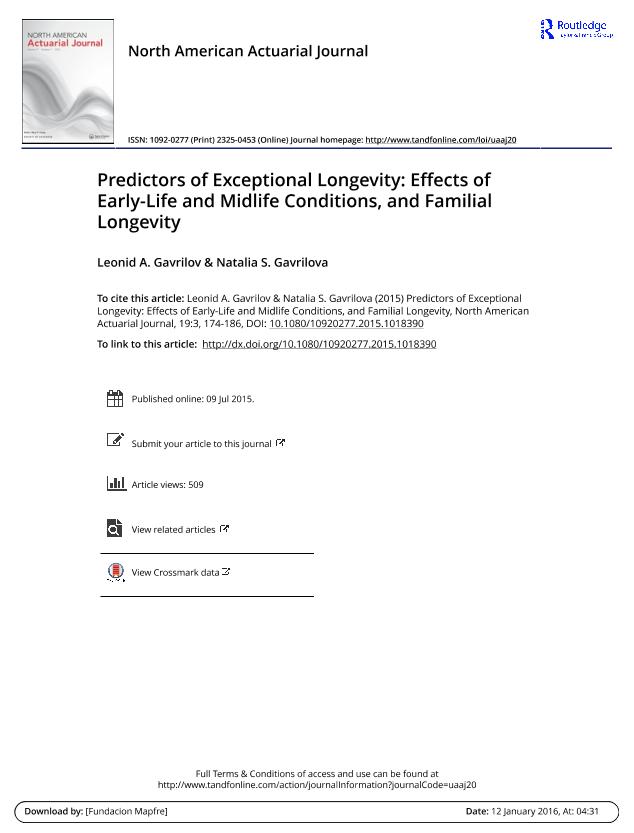Predictors of exceptional longevity : effects of early-life and midlife conditions, and familial longevity

Contenido multimedia no disponible por derechos de autor o por acceso restringido. Contacte con la institución para más información.
| Tag | 1 | 2 | Valor |
|---|---|---|---|
| LDR | 00000cab a2200000 4500 | ||
| 001 | MAP20160000979 | ||
| 003 | MAP | ||
| 005 | 20160122141601.0 | ||
| 008 | 160112e20151005esp|||p |0|||b|spa d | ||
| 040 | $aMAP$bspa$dMAP | ||
| 084 | $a341 | ||
| 100 | 1 | $0MAPA20110030940$aGavrilov, Leonid A. | |
| 245 | 1 | 0 | $aPredictors of exceptional longevity$b: effects of early-life and midlife conditions, and familial longevity$cLeonid A. Gavrilov, Natalia S. Gavrilova |
| 520 | $aKnowledge of strong predictors of mortality and longevity is very important for actuarial science and practice. Earlier studies found that parental characteristics as well as early-life conditions and midlife environment play a significant role in survival to advanced ages. However, little is known about the simultaneous effects of these three factors on longevity. This ongoing study attempts to fill this gap by comparing centenarians born in the United States in 18901891 with peers born in the same years who died at age 65. The records for centenarians and controls were taken from computerized family histories, which were then linked to 1900 and 1930 U.S. censuses. As a result of this linkage procedure, 765 records of confirmed centenarians and 783 records of controls were obtained. Analysis with multivariate logistic regression found the existence of both general and gender-specific predictors of human longevity. General predictors common for men and women are paternal and maternal longevity. Gender-specific predictors of male longevity are occupation as a farmer at age 40, Northeastern region of birth in the United States, and birth in the second half of year. A gender-specific predictor of female longevity is the availability of radio in the household according to the 1930 U.S. census. Given the importance of familial longevity as an independent predictor of survival to advanced ages, we conducted a comparative study of biological and nonbiological relatives of centenarians using a larger sample of 1,945 validated U.S. centenarians born in 18801895. We found that male gender of centenarian has a significant positive effect on survival of adult male relatives (brothers and fathers) but not female blood relatives. Life span of centenarian siblings-in-law is lower compared to life span of centenarian siblings and does not depend on centenarian gender. Wives of male centenarians (who share lifestyle and living conditions) have a significantly better survival compared to wives of centenarians' brothers. This finding demonstrates an important role of shared familial environment and lifestyle in human longevity. The results of this study suggest that familial background, some early-life conditions and midlife characteristics play an important role in longevity. | ||
| 650 | 4 | $0MAPA20080580377$aEsperanza de vida | |
| 650 | 4 | $0MAPA20080570590$aSeguro de vida | |
| 650 | 4 | $0MAPA20080555016$aLongevidad | |
| 650 | 4 | $0MAPA20080553883$aDemografía | |
| 650 | 4 | $0MAPA20120011137$aPredicciones estadísticas | |
| 650 | 4 | $0MAPA20080555306$aMortalidad | |
| 700 | 1 | $0MAPA20160000962$aGavrilova, Natalia S. | |
| 773 | 0 | $wMAP20077000239$tNorth American actuarial journal$dSchaumburg : Society of Actuaries, 1997-$x1092-0277$g05/10/2015 Tomo 19 Número 3 - 2015 , p. 174-186 |

